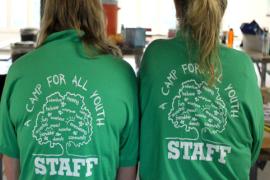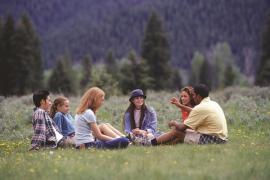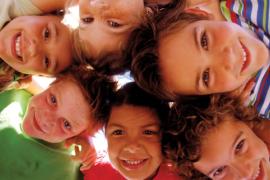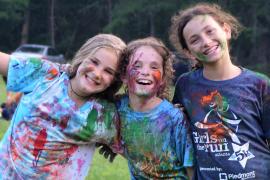You may be asking yourself, "What does a discussion about transgender individuals have to do with me? Why am I reading this in Camping Magazine?" We've had the conversation about the LGBTQ community (defined on page 44) in camps before (see "Don't Assume I'm Straight," in the November/December 2003 Camping Magazine). The time has come to focus on the special challenges facing certain members of that community — transgender youth — and what role camps might play.
While transgender individuals have only begun to gain more recognition and understanding recently, and transgender youth only in the last decade, there's nothing new about individuals whose gender identity doesn't fit into the gender binary. According to the Association of Gay and Lesbian Psychiatrists (AGLP), the first modern descriptions of individuals who felt as though they were of a different gender than their biological sex was in the mid-to-late 1800s (2007). The first sex-change surgery, surgery to correct the external appearance to that of the gender identity of the individual, occurred in 1931; the earliest, most notable sex-change operation was that of Christine Jorgenson in 1952, which publicly called attention to transsexualism (AGLP, 2007).
Perhaps some concern and discomfort from readers regarding this topic stems from the young age of camp "clientele." For many, the idea that a person may identify as a gender other than that of her or his biological sex could be difficult to conceptualize; much more difficult to imagine is a child feeling uncomfortable in her or his skin. In fact, most pediatric and psychiatric literature notes that children are first aware of gender and gendered differences around the age of two (Perrin, Menvielle, & Tuerk, n.d.), and according to the American Academy of Pediatrics, by age four, "gender identity is stable" (as cited in Trans Family Youth Allies, n.d.). Despite an outsider's appall that such a weighty decision — expressing one's gender identity — could be made at such a young age, perhaps gender identity decisions are most naturally made at that age, before becoming obscured by the convoluted knot of sexual attraction, gender roles, and societal pressures. When interviewed, many transgender adolescents and adults state that they have felt like a gender other than their biological sex from a very young age (Melby, 2008). While we have no way of knowing exactly how many youth identify as transgender or gender variant, as the world becomes a more open and understanding place, it is likely that more and more will feel safe being open about their gender identity.
Part of the journey to creating open and positive spaces for transgender people is eliminating some common misconceptions. It is important to recognize that gender identity and sexual orientation are not the same, and are not necessarily related. Just because an individual was born a biological male does not mean that individual will be attracted exclusively to those born as biological females. Just because an individual identifies as a male, regardless of biological sex, does not mean that individual will be attracted to a female gender identity, and vice versa. As mentioned previously, gender as a personal attribute is something that a child is aware of very early in life; sexual orientation, or which gender or genders one will be attracted to, is something that develops later, typically most clearly with the onset of puberty.
Truthfully, if you haven't already worked with a child who identified openly as transgender, chances are good that you will in the coming years. You may have already welcomed a child to your camp who struggles with her or his own gender identity, and you may not have known it. How an individual expresses her or his gender identity varies widely. Some individuals strongly identify with one gender or the other and choose for their outer appearance to represent their identity; others feel that their gender identity is on a fluid continuum and may express typically masculine or typically feminine characteristics at different occasions, or both simultaneously. Some adults choose to have gender affirming surgery to make their physical exterior match their gender identity, and some do not.
Challenges and Struggles
Transgender youth face many struggles daily — at school, in their communities, and even at home with their parents and families. For the past decade, the Gay, Lesbian and Straight Education Network (GLSEN) has been surveying LGBTQ youth about their experiences in our nation's schools. Although the overall findings have been disturbing regarding the challenges these young people face, in 2009, GLSEN focused special attention on the school and home lives of transgender and gender variant youth (GLSEN, 2009). It seems that school-aged youth may be the most rigid gender police, as GLSEN notes that "name calling and bullying based on gender expression are among the first forms of harassment that young people learn and experience" (GLSEN, 2009, p.5). Although transgender youth are often more likely than their LGB peers to speak up about sexual orientation and gender identity issues at school, they are also more likely to receive harassment and violent retribution, and their school work suffers more because of it (GLSEN, 2009).
School staff aren't always providing the necessary support; some transgender youth reported hearing disparaging remarks coming directly from school staff (GLSEN, 2009; McGuire & Conover-Williams, 2010), and stated that teachers and school authorities were less likely to intervene for sexual orientation or gender expression harassment than for other types of harassment (GLSEN, 2009). Harassment of transgender or gender variant youth goes far beyond name calling, and males are targeted more often than females. According to an article by Todd Melby in Contemporary Sexuality (2008), 14 percent of males and 5 percent of females have been attacked sexually because of gender identity. In the news recently, several examples of homicides and suicides have shed light on what could be the end result of this type of bullying — notably, a fourteen-year-old male, Lawrence King, was murdered at school for identifying openly as gay and engaging in gender nonconforming behavior (Melby, 2008). In their 2009 school climate survey for LGBTQ youth, GLSEN found a link between high levels of victimization and high levels of depression, high levels of anxiety, and low levels of self-esteem — this should be of no surprise to camping professionals who have worked to educate about the harm of bullying for many years.
Unfortunately, transgender youth aren't just facing harassment at school, but also in their communities and in their homes. Melby references a study done by Anthony D'Augelli, Arnold Grossman, and Michael Starks where LGB youth cite examples of verbal abuse from parents and other family members (2008). Additionally, Jenifer McGuire and Meredith Conover-Williams (2010), in their article "Creating Spaces to Support Transgender Youth" note that gender nonconforming youth "are more likely than LGB youth to experience family violence, parental rejection (Grossman, D'Augelli, & Salter, 2006), eviction, and loss of financial support (Garofalo et al., 2006; Xavier, 2000)." If these youth are evicted, social services agencies may not be any better in terms of climate. Mitchell Rosenwald notes that when LGBTQ youth enter the welfare system, "the barriers they face are heightened as they must negotiate a system that largely operates within a culture of heterosexism and homophobia, harassment, and violence" (Rosenwald, 2009).
Camp's Answer
So what is a camp to do? Clearly, transgender youth are struggling. At school, the atmosphere for many is hostile, and it may be even worse at home or in their communities. For many camps and camp professionals, there are still more questions than answers. Where will this camper live? How will we educate our staff, our campers, our families? What are our values as a camp family, and how will that impact these matters? Where will they use the restroom and shower? What sorts of activities will be appropriate?
There are many ways that these questions, and many others, can be answered — and no answer is simple or easy. How you address transgender or gender variant campers at your camp will depend on a number of factors — the camp mission and values, the board of directors or other important leadership, camp families, camp staff, the type of camp, and others. Because this is still a relatively new issue in camping, there aren't many answers or a lot of "best practices" to seek out. Every camp community is different, and for that reason, every camp community will have to answer these questions in its own unique way. There are a few things that every camp should be doing, if they haven't been done already.
Formulate a Plan
Even if you haven't been approached by a camper family with a transgender or gender variant child, chances are increasing that you will be at some point in the future. Be prepared, as this decision will likely involve many parties, and it will take some time to formulate a plan of action that works for your camp. At a staff meeting, at a monthly board meeting, or at another event where all of the pertinent parties are gathered, propose this topic.
Know Your Values
As a camp community, what is it that you seek to instill in all those you come in contact with? What is the essence of your camp? Make a decision that is values-based, but be wary of fear hidden behind "values" as a measure to eliminate the unknown from the camp community. Remember, every camp staff member, camper, and camper family will learn a lesson from how this is handled at your camp.
Educate Yourself and Your Staff
One of the biggest frustrations of members of minority groups tends to be the responsibility to educate everyone else about "their kind." It's exhausting, and pointless, as there is so much variety within every minority population that it's impossible for one person to tell the story of all — just as it is with the majority population. Taking a passive stance and waiting for others to inform you will lead to misunderstandings and frustrations on both sides. The sidebar on page 40 offers some helpful resources for camp professionals — take the initiative to know what you don't know, and then train others in your camp community to do the same. Shockingly, parents don't always tell us the things that we know to be so crucial before arriving at camp on opening day. And our tweens and teens don't always tell their parents information about themselves, like if they are struggling with or questioning their gender identity. Training yourself and your staff to understand and be aware of gender identity issues will lay the foundation for an open and peaceful community.
Consider how this issue fits into ACA's 20/20 Vision, which ACA members have undertaken with vigor. Perhaps, consider reaching our transgender and gender variant youth as a part of that 20 million children we're striving to serve; as noted in the 20/20 Vision, "we must advocate for children, youth, and families," (ACA, 2011). Isn't that what we've always said? With our bright smiles on opening day, our name games and our welcoming activities, our trust circles and our cabin meetings, our homesickness cures and our tearful goodbyes — through all of these things and many more, we say come as you are to our campers and their families. Why should our treatment of transgender and gender variant youth be any different?
The Lingo
A few terms to help us better understand this conversation:
Gender Binary
The two commonly understood genders, male and female, with all of the societal reinforcements that accompany those genders (i.e. — men act in a masculine way and avoid stereotypically feminine behaviors; women act in a feminine way and avoid stereotypically masculine behaviors); the gender binary is seen as too limited and restrictive for the many individuals who don't fit easily into one category.
Gender Expression
The way individuals display their understanding of their own gender identity to others, through all of the ways our society identifies gender — clothing, hair styles, makeup, presence, etc.
Gender Identity
Separate from biological sex, gender identity reflects how individuals understand their own gender, or even a non-gender.
Gender Reconstructive Surgery / Sexual Reassignment Surgery
Surgical procedures that individuals may elect to have so that their bodies more accurately reflect their gender identity.
Gender Transition
Medical Gender Transition: Physical changes, such as through gender-affirming surgery / sexual reassignment surgery and/or hormonal therapy that result in one's physical appearance affirming one's gender identity; not all transgender individuals choose to take hormones or undergo gender affirming surgery.
Social Gender Transition: Many individuals may choose not to undergo a medical gender transition, but will experience a social transition and will consider themselves to be post-transition if they are living as a gender different from the one assigned at birth.
LGBTQ
Stands for Lesbian, Gay, Bisexual, Transgender, and Queer (occasionally a second Q, meaning Questioning, will also be present); the letters together represent a community of people who experience oppression on the basis of sexual orientation or gender identity.
Queer
A term used by individuals who do not identify as heterosexual, but are not comfortable labeling themselves gay, lesbian, or bisexual, and consider their sexuality on a continuum. Queer or genderqueer may also be used by an individual who doesn't feel they fit into the gender binary of male or female, but that their gender identity falls somewhere along a continuum between male and female.
Sexual Orientation
Refers to the gender that one is attracted to (in a romantic, emotional, and spiritual way); the commonly understood sexual orientations are gay, lesbian, bisexual, heterosexual, and queer.
Transgender
An umbrella term used broadly to describe individuals who identify as a gender different from that of their biological sex, or see their gender identity as fluid and not conforming to the gender binary.
Author's Note: A very special thanks to Nick Teich, who provided valuable terminology, feedback, and support for this article.
References
Gay, Lesbian, and Straight Education Network. (2009). The 2009 national school climate survey executive summary. Washington, DC: GLSEN.
Gay, Lesbian, and Straight Education Network. (2009). Harsh realities: The experiences of transgender youth in our nation's schools. Washington, DC: GLSEN.
Grossman, A. H., D'Augelli, A. R., Howell, T. J., & Hubbard, S. (2005). Parents' reactions to transgender youths' gender nonconforming expression and identity. Journal of Gay & Lesbian Social Services, 18(1), 3-16.
McGuire, J. K., & Conover-Williams, M. (2010). Creating spaces to support transgender youth. The Prevention Researcher, 17(4), 17-20.
Melby, T. (2008). Courageous lives, complex choices. Contemporary Sexuality, 42(4), 3-6.
Perrin, E. C., Menvielle, E. J., & Tuerk, C. (n.d.). To the beat of a different drummer: The gender variant child. Contemporary Pediatrics.
Rosenwald, M. (2009). A glimpse within: An exploratory study of child welfare agencies' practices with LGBTQ youth. Journal of Gay and Lesbian Social Services, 21, 343-356.
Trans Youth Family Allies, Inc. (n.d.). Information for school administrators and educators. Retrieved from www.imatyfa.org/educators/index.html
Trans Youth Family Allies, Inc. (2008). Learning the Lingo. Retrieved from www.imatyfa.org.
Sarah Holder currently works for the University of North Carolina at Charlotte, in Charlotte, North Carolina. She worked as a camping professional before transitioning to higher education, and her professional interests include gender and LGBT studies and staff training and development. Contact the author at [email protected].
Originally published in the 2011 September/October Camping Magazine.




